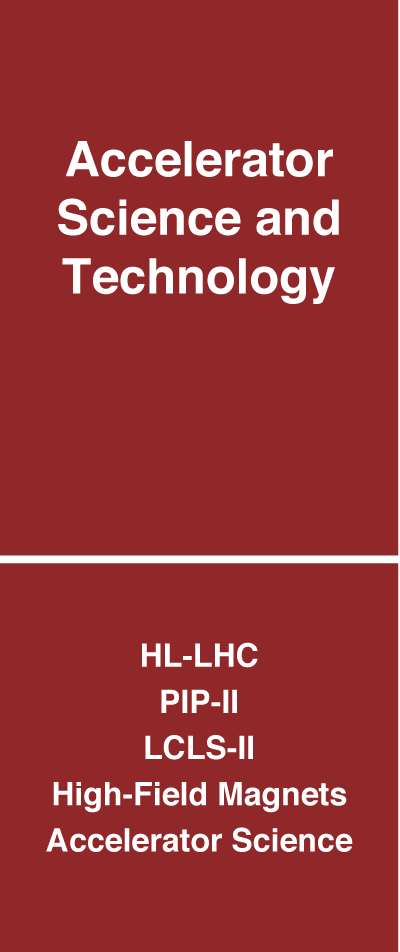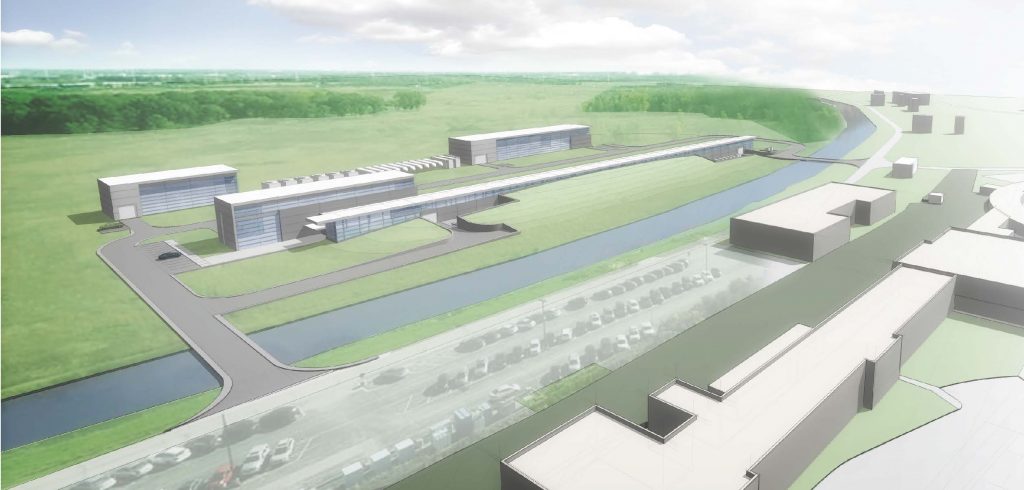Accelerator Science and Technology
Fermilab’s core capability in accelerator science and technology powers particle physics discoveries and makes significant contributions to research in other scientific disciplines. The laboratory’s accelerator science and technology strategy is motivated by the P5 report, which identified the need for accelerated beams to investigate four of its five science drivers. Recommendations from the HEPAP accelerator R&D subpanel strongly endorse Fermilab’s plans to pursue an aggressive research program funded by DOE’s General Accelerator R&D (GARD) program. The program includes superconducting radio-frequency (SRF) acceleration technology, high-field superconducting magnets, beam physics, and high-power targets. Over the next 10 years, Fermilab will make significant contributions to CERN’s HL-LHC accelerator upgrade, the PIP-II project that upgrades Fermilab’s accelerator complex for LBNF/DUNE, and SLAC’s LCLS-II project. The following five major initiatives comprise the laboratory’s strategy for accelerator science and technology.
HL-LHC
CERN is planning a major upgrade of the Large Hadron Collider that will increase instantaneous luminosity by ten times compared to the LHC’s luminosity in 2012. The High-Luminosity LHC (HL-LHC) accelerator upgrade, scheduled for 2024-2025, is a major initiative for Fermilab that requires significant advances in accelerator science and technology. Fermilab is leading the U.S. contribution to HL-LHC R&D through the ongoing LHC Accelerator Research Program (LARP), which is the U.S. national program that funds accelerator research in support of the LHC. LARP is expected to complete its HL-LHC R&D effort in FY 2018 following the delivery of two prototypes for the HL-LHC upgrade. A pre-series magnet and a cold-mass prototype will be developed and tested by the U.S. HL-LHC Accelerator Upgrade Project (HL-LHC AUP). This project will deliver the components to CERN that will encompass the U.S. contribution to the HL-LHC upgrade. Fermilab will lead this project, working in conjunction with DOE and CERN to define deliverables. The project is expected to achieve CD-1 in FY 2017, and a consolidated CD-2/CD-3 in FY 2018. Achieving CD-3a in advance of FY 2018 for long-lead time procurements such as superconductor, assembly tooling, and magnet parts is under consideration to meet the delivery schedule requested by CERN.
The LARP program will be recast after the spin-off of the HL-LHC AUP project in FY 2019. The continuation of a Fermilab fellowship program (Toohig Fellowship) for postdoctoral researchers interested in pursuing studies in accelerator science is expected to take place under a new program, with goals established by DOE/HEP in the coming year. The new goals are not expected to include superconducting magnet development activities, but may include accelerator studies and R&D at the HL-LHC.
PIP-II
Over the next ten years a two-stage upgrade will increase the power of Fermilab’s proton beams, enabling the laboratory’s flagship neutrino and precision science programs. Beam power delivered to the NuMI facility has been increased to 700 kW by the Proton Improvement Plan (PIP) and by upgrades to the Recycler. Recent improvements include beam loss reduction and capture, new transverse dampers for slipstacking, and reliability improvements that resulted in record beam delivery to both the Booster and NuMI neutrino beams. Following the completion of PIP, the Fermilab Accelerator Complex will be unique in the world in its ability to deliver beams simultaneously to both neutrino and precision science programs. The PIP-II project, a major initiative for Fermilab, will further increase the power to 1.2 MW as required for LBNF/DUNE while enabling further performance enhancements to the precision science program. SRF, the technology chosen for PIP-II, is the only modern technology suitable for continuous-wave accelerators, as would be required for a second-generation Mu2e experiment. The siting of PIP-II (see figure on following page) was chosen to be consistent with providing a platform for long-term development of the Fermilab Accelerator Complex.
The PIP-II project received CD-0 in the fall of 2015 and is now working toward a goal of CD-1 approval in late 2017. In addition to project-definition activities, PIP-II is supported by a comprehensive R&D program pursued as a collaboration of the DOE, the Indian Department of Atomic Energy (DAE), and the Italian Istituto Nazionale di Fisica Nucleare (INFN). Over the next five years this program incorporates R&D aimed at demonstrating state-of-the-art performance in the PIP-II low-energy front end and development of SRF systems required for acceleration of proton beams. Fermilab is working with Argonne National Laboratory (ANL) to develop and build a low-frequency half-wave resonator SRF cryomodule for PIP-II. ANL’s expertise in this area is complementary to Fermilab’s SRF capabilities. These major elements of the program are accompanied by comprehensive theoretical and experimental investigations of major loss mechanisms and beam instabilities in the laboratory’s existing Booster, Main Injector, and Recycler proton accelerator complex. High-intensity targets and focusing systems are crucial, and R&D to improve them will be actively pursued. Advanced computer modeling and simulation of beams with space charge in realistic ring environments will benefit both the Fermilab Accelerator Complex upgrades as well as other existing accelerators.
LCLS-II
At the center of Fermilab’s accelerator technology activities is the superconducting radio-frequency program. SRF is the enabling technology for future-generation high-intensity accelerators that are at the core of the missions of DOE/HEP and the Office of Science. Fermilab’s world-leading SRF capabilities and infrastructure were enabled by an approximately $200M investment by DOE/HEP over the last decade. Currently, Fermilab’s SRF program focuses on three major areas: production of LCLS-II cryomodules in close partnership with SLAC National Accelerator Laboratory and Thomas Jefferson National Accelerator Laboratory, directed R&D for PIP-II, and advanced accelerator R&D on basic SRF science and cavity development for future accelerators. The laboratory’s SRF expertise is a key enabler of SLAC’s LCLS-II accelerator project. Experience, knowledge, and infrastructure developed through the LCLS-II project will subsequently be applied to the lab’s PIP-II project.
The DOE/HEP investment in the Fermilab SRF R&D program has led to major breakthroughs – such as nitrogen doping and infusion and magnetic flux expulsion – that dramatically increase the SRF cavity quality factor (Q0) and hence reduce operating costs. LCLS-II is the first benefactor of this success, and the current LCLS-II design depends on transitioning these results from R&D to production and operations. Fermilab plays a key role in this endeavor by providing overall technical leadership. A thorough understanding of the underlying physics is crucial to realize the full potential of these breakthroughs and to transfer benefits to all future SRF accelerators. Over the next few years, fundamental investigations into the physics of quality factor limitations at low and high fields will be actively pursued in collaboration with laboratories (CERN, KEK, TJNAF) and international and U.S. universities (for example, Cornell University, Illinois Institute of Technology, Northern Illinois University, Northwestern University, and the University of Chicago). A Fermilab-Northwestern Center for Applied Physics and Superconducting Technologies (CAPST) has been established to facilitate long-term collaboration in the fields of mutual interest and to leverage strengths of the two institutions. A primary goal is to decrease capital costs and operational cryogenic costs of future continuous-wave accelerators by a factor of two or more.
Fermilab has a nascent effort to develop detector technology for LCLS-II. The laboratory’s Application Specific Integrated Circuit (ASIC) design group collaborates with SLAC’s detector development group to develop a next-generation, very-high-readout-speed X-ray detector for use at the LCLS-II facility. This effort will leverage experience gained by the Fermilab ASIC group in the development of high-speed readout chips for HEP silicon vertex detectors and in collaborative efforts with Argonne National Laboratory and Brookhaven National Laboratory in the development of X-ray detector systems for use at the Argonne Advanced Photon Source and at the National Synchrotron Light Source II (NSLS-II) at Brookhaven.
High-field Magnets
Fermilab is home to world-class R&D facilities and is a world leader in high-field superconducting accelerator magnets, materials, and technology R&D. Cost-effective superconducting accelerator magnets with operating fields up to 16 Tesla are being considered for the LHC energy upgrade (HE-LHC) and a future proton-proton circular collider (FCC) under study at CERN and in China. To demonstrate the feasibility of such magnets, Fermilab, as a key partner in the recently established U.S. Magnet Development Program (MDP) together with Lawrence Berkeley National Laboratory and the National High Magnetic Field Laboratory (Florida State University), has initiated and is leading the development of a 15 Tesla dipole demonstrator based on Nb3Sn superconductor. Fermilab researchers perform extensive magnet design studies to explore the limit of the Nb3Sn accelerator magnet technology, optimize magnet design and performance parameters, and reduce magnet cost. Fermilab will contribute to the MDP effort to develop and evaluate generic technology of high-temperature superconductor inserts with the possibility of producing fields up to 20 Tesla.
Fermilab is conducting extensive superconducting wire and cable R&D with the goals of improving key properties and providing conductor specifications for the design and construction of superconducting accelerator magnets. Superconducting wire R&D is focused on 1) optimizing state-of-the-art Nb3Sn composite wires, 2) developing Nb3Sn wires with substantially higher critical current density in high fields by introducing artificial pinning centers, and 3) developing Nb3Sn wires with increased specific heat to improve conductor stability and reduce sensitivity to external perturbations. Rutherford cable R&D includes heat treatment studies to boost the performance of present cables and innovative design ideas for the larger cables that are preferred for high-field accelerator magnets.
Accelerator Science
Over the next five years Fermilab will establish a fully operational test facility to address key questions related to intense beams for future, cost-effective accelerators. The facility will enable transformative accelerator science. The central component of the test facility is the Integrable Optics Test Accelerator (IOTA), an innovative nonlinear storage ring that will include a proton and ion injector as well as a world-class high-brightness electron injector. Fermilab will complete construction and begin commissioning IOTA in 2017 by leveraging GARD funding together with LDRD funds. The laboratory will build community interest through university-lab partnerships, develop a focused science program via directed workshops, and produce a schedule for implementing the IOTA science program collaboratively with partners. IOTA scientific output will be critical to define the next steps in high-intensity particle beam development beyond PIP-II, and to establish novel approaches to advanced beam physics research.



